Excerpts from Jim Conrad's
Naturalist Newsletter
From the February 11, 2008 Newsletter written in the community of 28 de Junio and issued from a ciber in San Francisco Pujiltic, Chiapas, MÉXICO; I'm at about 800 meters in elevation, ± LAT 16° 18'N, LONG -92° 28'W.
RAMÓN FRUITS
In certain parts of this community's small reserve Ramón is the most common tree. They're old, stately trees, too, producing enormous quantities of fruits, which in some places cover the ground as if someone had spilled a big bag of brown marbles. You can see several fruits in various states of maturity below:
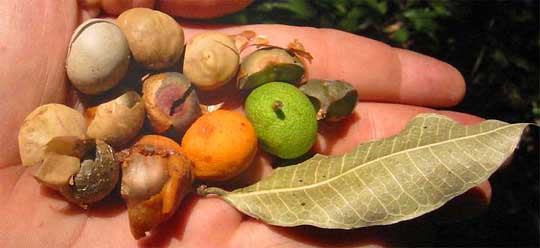
In that picture a dry Ramón leaf displays its typical herring-bone pattern venation. Ramón is a member of the Fig Family so it's looking like a leaf from an American strangler fig is no accident.
Also you can see that the fruit's hard, nutlike part is covered by a warty skin that's orange when mature. That covering is mildly sweet and not bad to eat, but the main eating is in the nut part.
People here call the tree and its fruit "Talcoít." When my friend Antonio saw me carrying the Ramón fruits to photograph he told me he'd fix me a meal by boiling the hard nuts with ashes, the ashes needed to help the hard fruits soften. Later that day he brought me what he'd promised, shown below.

They tasted a little like boiled peanuts and had the same texture. Antonio eats them and other things he finds in the forest, and tells about a famine that came through here years ago, maybe in the 20s he says, when all the crops failed but people kept alive eating this fruit. I think I've read that the ancient Maya depended on them the same way, often storing them for long periods. The tree's leaves and young branches are much used as livestock food.
My Plantas Medicinales de México says that the white-latex-producing fruits are used to encourage new mothers to lactate, but around here the trees and their fruits aren't regarded as medicinal. I read that the fruits can be roasted, ground, and the resulting powder used to make a drink rather like coffee.
This is simply one of the most useful and wonderful trees I know and should be planted throughout the world's tropics in anticipation of a collapse of the international trading system. As we've seen it goes by a host of local names. The name to remember is its Latin one, BROSIMUM ALICASTRUM.
From the February 18, 2008 Newsletter written in the community of 28 de Junio and issued from a ciber in San Francisco Pujiltic, Chiapas, MÉXICO; I'm at about 800 meters in elevation, ± LAT 16° 18'N, LONG -92° 28'W.
MAKING RAMÓN COFFEE
Last week I mentioned the wonderful fruits of our Ramón trees, BROSIMUM ALICASTRUM, of the Fig Family. This week Eliezer and I made coffee of them.
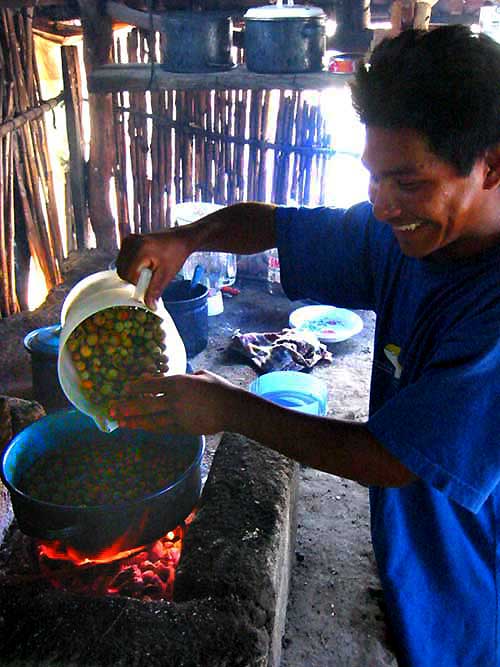
Above you see Eliezer pouring Ramón fruits into a pan over a fire blazing on a traditional Maya, elevated fireplace of the kind I modeled my fireplace after when I was a hermit back in Mississippi. Below, Eliezer is grinding the toasted fruits into a fine powder.
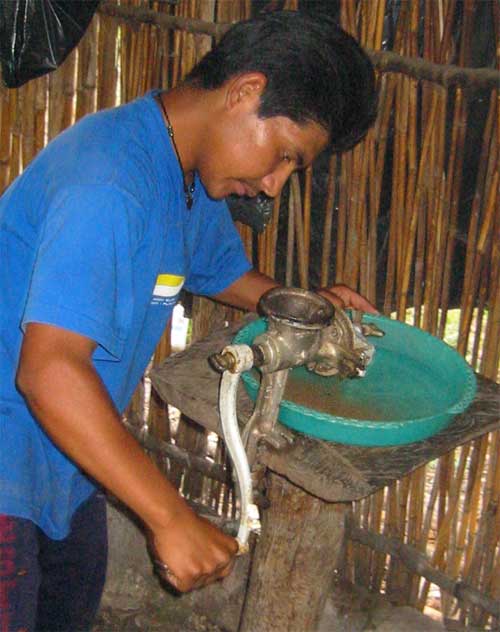
Finger-long strips of cinnamon bark also were ground with the fruits. As soon as the powder's rich fragrance reached our noses we began suspecting we had something good.
After boiling the powder mix for several minutes we ceremoniously poured the whole family sweetened cups of brew, and... it was delicious. People who'd eaten boiled Ramón fruits all their life and seen untold millions of brown Ramón fruits lying unharvested along trails through the forest simply couldn't believe such a tasty drink could be made from them. Old men shook their heads and grinned, and little kids wanted more.
Now we have to learn how to streamline the process so that the price people are willing to pay for a cup of Ramón coffee makes it worthwhile for someone to pick the fruits off the ground, dry and parch them, grind them into fine powder, package the powder, and finally market and sell it.
Entry issued on May 24, 2019, from Tepakán, Yucatán, MÉXICO
RAMÓNS FLOWERING
Nowadays when the big Ramón beside the windmill is approached, you hear a tremendous buzzing of bees. The Ramóns are flowering now, and if somehow you don't notice that because of the bees, beneath the tree the ground is littered with clusters of Ramón flowers, little yellow spheres covered with white sandgrain-like things, as shown below:
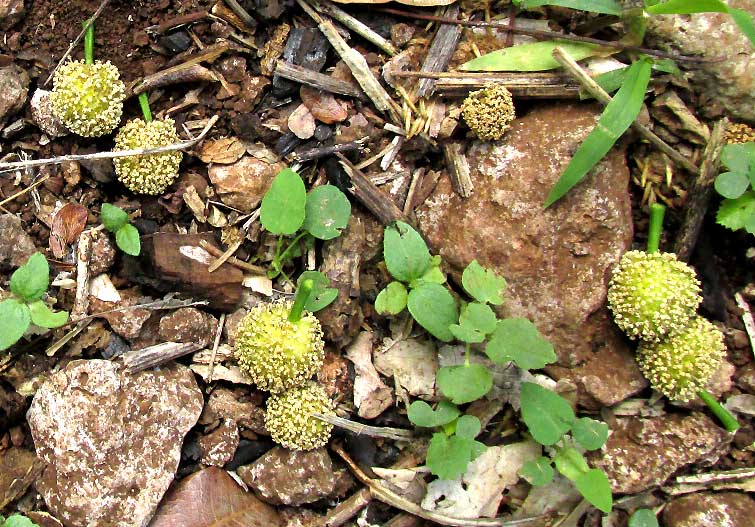
Despite so many flowers on the ground, up in the tree there are even more, many thousands of them, as shown below:
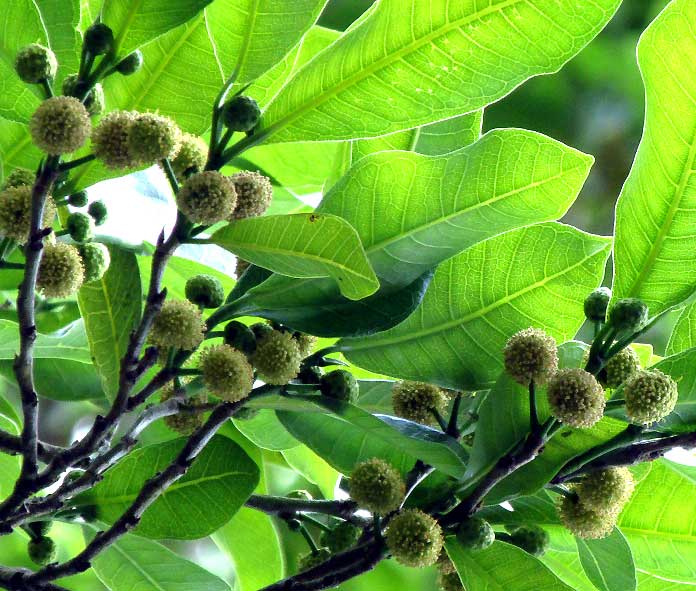
In that picture, some of the flowering structures are pale and fuzzy while others are green, smooth and smaller. The pale, fuzzy items are clusters of male flowers, while the smaller, smooth ones are clusters of female flowers. A close-up of two female structures appears below:
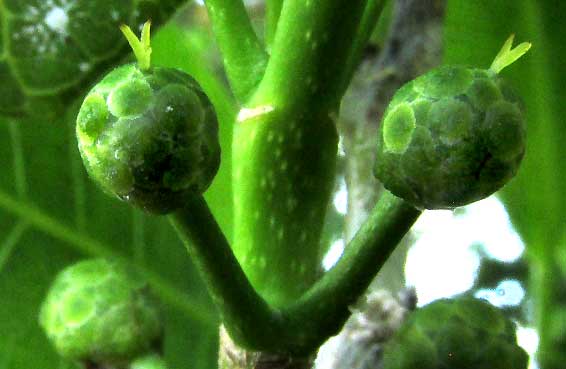
Ramón is a member of the Fig Family, the Moraceae, whose species produce unisexual flowers. Each structure shown above consists of one or two female flowers surrounded by a protective covering of round, scale-like bracts, bracts being highly modified leaves. The slender, greenish yellow items extending from the flowering structures are the female flowers' stigma lobes, where pollen is supposed to land, carrying the male sex germ. With this in mind, we can break open a cluster of male flowers, to see what's shown below:

The green item at the bottom is the cluster's stem, or peduncle. Most of the cluster body consists of a spongy matrix, and this matrix is encrusted with many closely packed male flowers, each flower consisting of little more than a single stamen. In the picture you can make out many whitish, stem-like filaments atop which stand knobby, brownish anthers in which pollen is formed, and released from slits at their bases.
Interestingly, another large Ramón stands beside the rock hut in which I live. Though it bears many thousands of female flowering structures, I can't find a single male one. The windmill Ramón also bears mostly female flowers, though some branches, as with the one illustrated above, are mostly male.
Ramóns occur from southern Mexico and the Caribbean area south to Brazil.
from the February 11, 2008 Newsletter written in the community of 28 de Junio and issued from a ciber in San Francisco Pujiltic, Chiapas, MÉXICO; I'm at about 800 meters in elevation, ± LAT 16° 18'N, LONG -92° 28'W.
BUTTRESSED TREE TRUNKS
While gathering Ramón fruits I photographed the base of a Ramón tree trunk in order to show something of which you see a lot around here, a buttressed tree-trunk. Buttressed trunks have widely flaring supports rather like the fins on a rocket, as shown below:

Buttresses help big trees remain upright in soggy ground. Having buttresses must be very effective, because they develop among many unrelated tree species. You see them on certain species of strangler figs, on Ceibas, Mahoganies, Cedros (Spanish Cedars) and many other large and noble trees of the hot, humid lowlands.